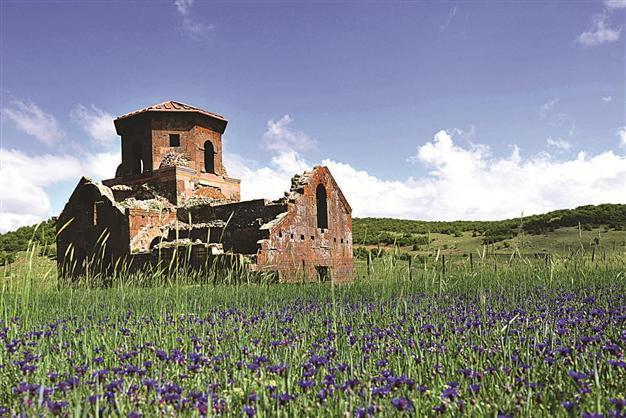Centuries-old church rescued in Cappadocia
AKSARAY - Anadolu Agency

The Red Church was listed as one of the 100 World Heritage sites in danger in 2008. After its dome, the other parts of the church will also be restored to attract tourists. AA photos
The roof of a 1,500-year-old church in the central Anatolian region of Cappadocia has begun to be restored before its collapse. Now, officials need resources for the restoration of the other parts of the Red Church (Kızıl Kilise), which was included in the 2008 World Monuments Watch.The Paris-based Cappadocia Friends Association’s Turkey representative Osman Diler said the association was established in 1995 for the Red Church to be restored and gain in tourism. He said the church was included on the list of the World Monuments Watch as a result of the association’s works.
“The Red Church was listed as one of the 100 World Heritage in Danger in 2008. This situation made things easier for us to promote the church and find resources,” he said.
Diler said the Red Church was one of the first churches in the Cappadocia region and had a significant place in faith tourism. “After St. Gregorius, who was one of the founders of Orthodoxy in the 4th century, returned to Güzelyurt, he spent the last days of his life on a farm in the area of the current Red Church. After his death, the Red Church was built in the 6th century, in 560, according to the carbon analysis results. The church has become one of the frequent worship places of Christians on their way to the pilgrimage [to Jerusalem],” Diler said.
Restoration of the church
Diler said the restoration of the Red Church had started in 2011 while it was in danger of collapse, and they received support from France, the U.S., Greece and Turkey.
“The cost of the restoration project was nearly 500,000 euros. We started restorations with the support from our members in those countries, benefactors and foundations. For the restoration process, headed by retired Professor İsmet Ağaryılmaz of Yıldız Technical University Faculty of Architecture Restoration Department, we received the necessary permission, wrote a contract with a firm and completed the first stage. The restoration was divided into a few stages. The dome of the church was about to collapse. We first refurbished the dome and finished 30 percent of the restoration. We need cooperation. We continue seeking resources from France, the U.S. and Turkey. We will start the second stage when we find the resources,” Diler said.
Diler also highlighted concerns regarding excavations on the Red Church and in its vicinity, adding, “Because there are no settlements around the church, illegal excavations are carried out in the area. Even though the gendarmerie sends its teams regularly, the church urgently needs a watchman for protection.”
He said foreign tourists’ interest in the church has increased in recent years. “Tourists come to the church in groups. When the restoration is done, this interest will increase more. Then we can sell tickets and earn revenue,” he concluded.
A Byzantine church
The Red Church is one of the oldest churches on the vast plains of the Cappadocia region. It was built during the reign of Byzantine Emperor Justinian. Unlike other churches in the region carved from volcanic rock, the church’s structure employs traditional masonry building methods and exemplifies the high quality of craftsmanship of the area at that time.
The central dome, supported by an octagonal base, is the most prominent architectural element of the church, featuring various types of volcanic stone. Light illuminates the interior through windows located at the base of the building. Evidence of huge lintels and precisely cut granite blocks indicate that the church served as an imperial, or funerary, chapel. The site was also a stop for pilgrims on their way to Jerusalem.

















